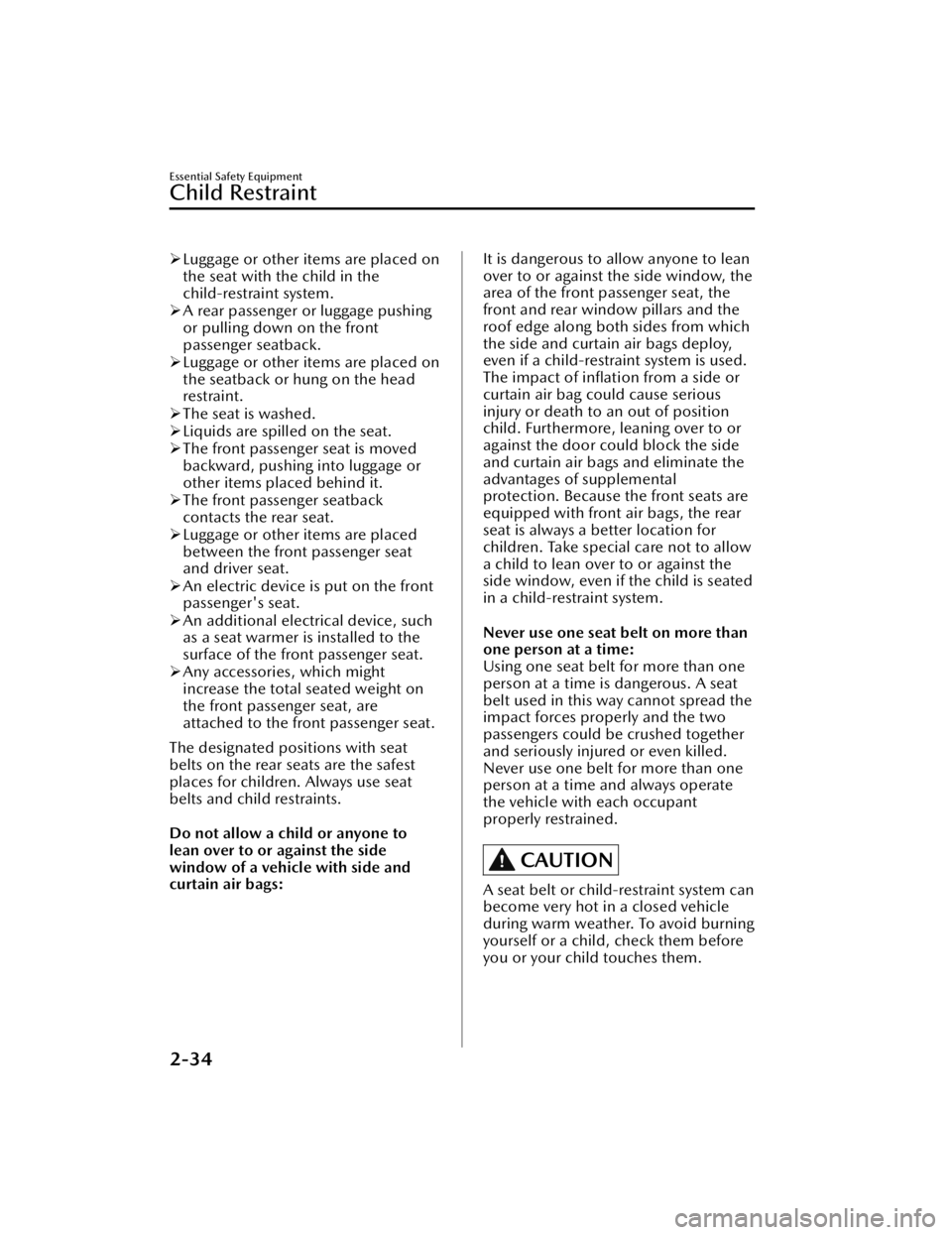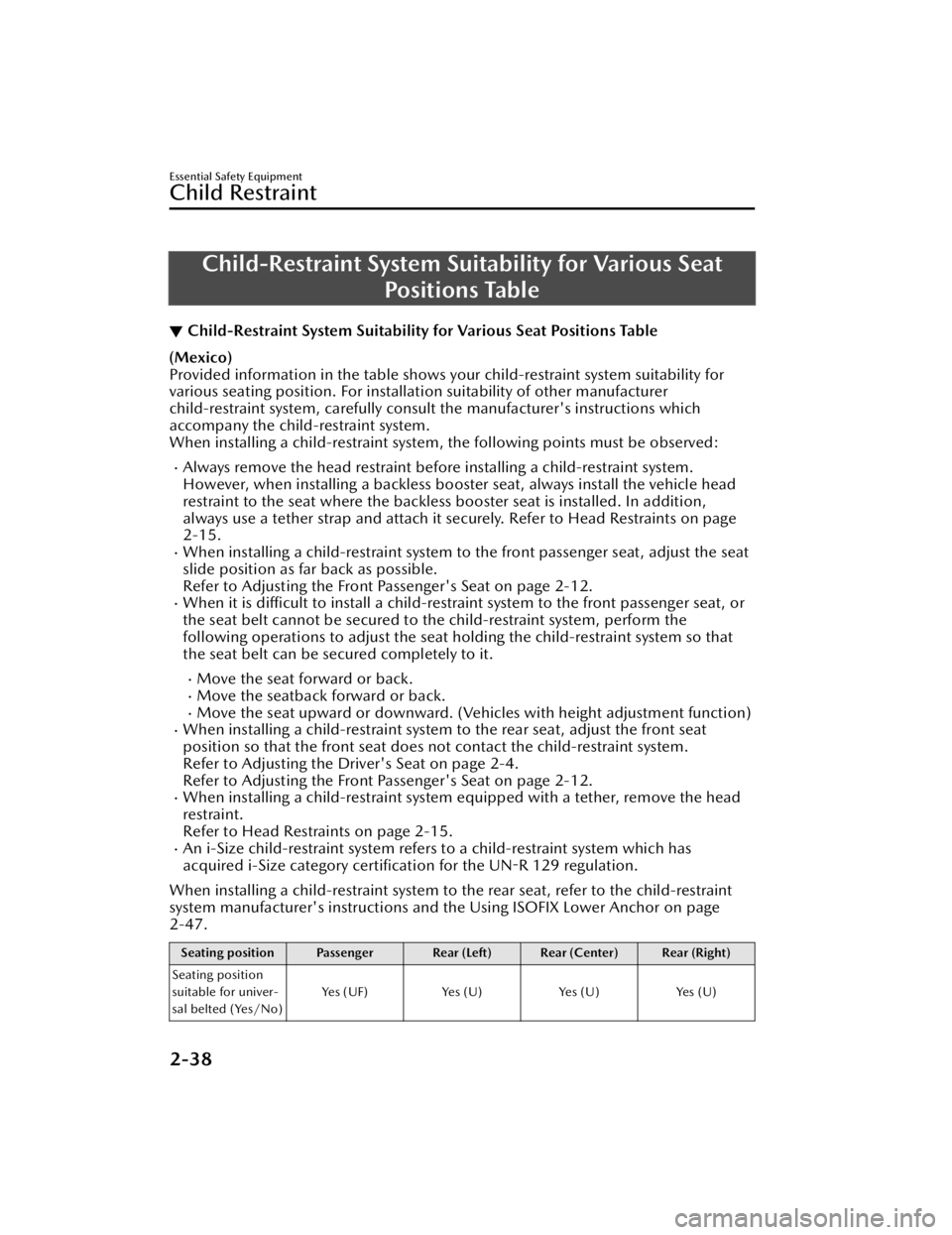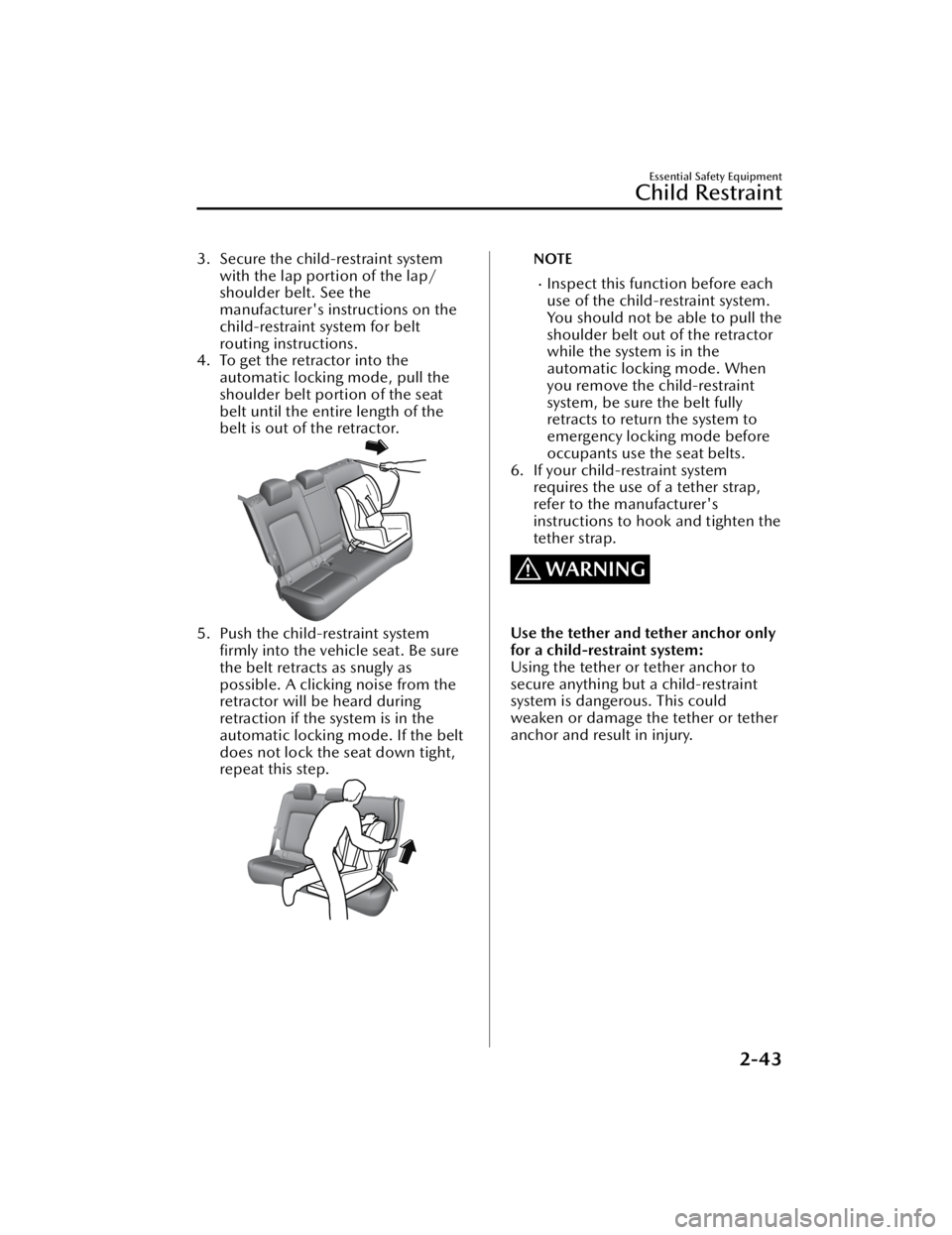MAZDA MODEL CX-50 2023 Workshop Manual
Manufacturer: MAZDA, Model Year: 2023, Model line: MODEL CX-50, Model: MAZDA MODEL CX-50 2023Pages: 583, PDF Size: 85.63 MB
Page 51 of 583

Luggage or other items are placed on
the seat with the child in the
child-restraint system.
A rear passenger or luggage pushing
or pulling down on the front
passenger seatback.
Luggage or other items are placed on
the seatback or hung on the head
restraint.
The seat is washed.
Liquids are spilled on the seat.
The front passenger seat is moved
backward, pushing into luggage or
other items placed behind it.
The front passenger seatback
contacts the rear seat.
Luggage or other items are placed
between the front passenger seat
and driver seat.
An electric device is put on the front
passenger's seat.
An additional electrical device, such
as a seat warmer is installed to the
surface of the front passenger seat.
Any accessories, which might
increase the total seated weight on
the front passenger seat, are
attached to the front passenger seat.
The designated positions with seat
belts on the rear seats are the safest
places for children. Always use seat
belts and child restraints.
Do not allow a child or anyone to
lean over to or against the side
window of a vehicle with side and
curtain air bags:It is dangerous to allow anyone to lean
over to or against the side window, the
area of the front passenger seat, the
front and rear window pillars and the
roof edge along both sides from which
the side and curtain air bags deploy,
even if a child-restraint system is used.
The impact of inflation from a side or
curtain air bag could cause serious
injury or death to an out of position
child. Furthermore, leaning over to or
against the door could block the side
and curtain air bags and eliminate the
advantages of supplemental
protection. Because the front seats are
equipped with front air bags, the rear
seat is always a better location for
children. Take special care not to allow
a child to lean over to or against the
side window, even if the child is seated
in a child-restraint system.
Never use one seat belt on more than
one person at a time:
Using one seat belt for more than one
person at a time is dangerous. A seat
belt used in this way cannot spread the
impact forces properly and the two
passengers could be crushed together
and seriously injured or even killed.
Never use one belt for more than one
person at a time and always operate
the vehicle with each occupant
properly restrained.
CAUTION
A seat belt or child-restraint system can
become very hot in a closed vehicle
during warm weather. To avoid burning
yourself or a child, check them before
you or your child touches them.
Essential Safety Equipment
Child Restraint
2-34
CX-50_8KB8-EA-22A_Edition2_new 2022-1-6 14:55:18
Page 52 of 583

NOTE
Your Mazda is equipped with ISOFIX/
LATCH*1 lower anchors for attachment
of specially designed ISOFIX/LATCH*1
child-restraint systems on the rear
seats. When using these anchors to
secure a child-restraint system, refer to
"Using ISOFIX Lower Anchor
(Mexico)/Using LATCH Lower Anchor
(Except Mexico)" (page 2-47).
*1 ISOFIX (Mexico)/LATCH (Except Mexico)
Essential Safety Equipment
Child Restraint
2-35
CX-50_8KB8-EA-22A_Edition2_new 2022-1-6 14:55:18
Page 53 of 583

Child-Restraint System Installation
▼Categories of Child-Restraint Systems
NOTE
When purchasing, ask the manufacturer of the child-restraint system which type of
child-restraint system is appropriate for your child and vehicle.
(Mexico)
Child-restraint systems are classified into the following 5 groups according to the
UN-R 44 and UN-R 129 regulation.
Group
Age WeightSize Classification/
Fixture (CRF)
0 Up to about 9 months old Up to 10 kg (up to 22 lb) ISO/L1
ISO/L2
ISO/R1
0+ Up to about 2 years old Up to 13 kg (up to 29 lb) ISO/R1
ISO/R2
ISO/R3
1 About 8 months to 4 years old 9 kg ― 18 kg (20 lb ― 40 lb) ISO/R2
ISO/R3
ISO/F2
ISO/F2X ISO/F3
2 About 3 to 7 years old 15 kg ― 25 kg (33 lb ― 55 lb) ―
3 About 6 to 12 years old 22 kg ― 36 kg (48 lb ― 79 lb) ―
(Except Mexico)
Please comply with the legal regulation s concerning the use of child-restraint
systems in your country.
▼ Child-Restraint System Types
In this owner's manual, explanation of
child-restraint systems is provided for
the following three types of popular
child-restraint systems: infant seat,
child seat, booster seat.
NOTE
Installation position is determined by
the type of child-restraint system.
Always read the manufacturer's
instructions and this owner's manual
carefully.
Essential Safety Equipment
Child Restraint
2-36
CX-50_8KB8-EA-22A_Edition2_new
2022-1-6 14:55:18
Page 54 of 583

Due to variations in the design of
child-restraint systems, vehicle seats
and seat belts, all child-restraint
systems may not fit all seating
positions. Before purchasing a
child-restraint system, it should be
tested in the specific vehicle seating
position (or positions) where it is
intended to be used. If a previously
purchased child-restraint system
does not fit, you may need to
purchase a different one that will.
Infant seat
An infant seat provides restraint by
bracing the infant's head, neck and
back against the seating surface.
Equal to Group 0 and 0+ of the UN-R
44 and UN-R 129 regulation.
Child seat
A child seat restrains a child's body
using the harness.
Equal to Group 1 of the UN-R 44 and
UN-R 129 regulation.
Booster seat
A booster seat is a child restraint
accessory designed to improve the fit
of the seat belt system around the
child's body.
Equal to Group 2 and 3 of the UN-R
44 and UN-R 129 regulation.
1. Full booster seat
2. Backless booster seat
When using a backless booster seat,
always install the vehicle head restraint
to the seat where the backless booster
seat is installed.
Essential Safety Equipment
Child Restraint
2-37
CX-50_8KB8-EA-22A_Edition2_new 2022-1-6 14:55:18
Page 55 of 583

Child-Restraint System Suitability for Various SeatPositions Table
▼Child-Restraint System Suitability for Various Seat Positions Table
(Mexico)
Provided information in the table shows yo
ur child-restraint system suitability for
various seating position. For installation suitability of other manufacturer
child-restraint system, carefully consult the manufacturer's instructions which
accompany the child-restraint system.
When installing a child-restraint system , the following points must be observed:
Always remove the head restraint before installing a child-restraint system.
However, when installing a backless booster seat, always install the vehicle head
restraint to the seat where the backless booster seat is installed. In addition,
always use a tether strap and attach it securely. Refer to Head Restraints on page
2-15.
When installing a child-restraint system to the front passenger seat, adjust the seat
slide position as far back as possible.
Refer to Adjusting the Front Passenger's Seat on page 2-12.
When it is difficult to install a child-restraint system to the front passenger seat, or
the seat belt cannot be secured to the child-restraint system, perform the
following operations to adjust the seat holding the child-restraint system so that
the seat belt can be secured completely to it.
Move the seat forward or back.Move the seatback forward or back.Move the seat upward or downward. (Veh icles with height adjustment function)When installing a child-restraint system to the rear seat, adjust the front seat
position so that the front seat does not contact the child-restraint system.
Refer to Adjusting the Driver's Seat on page 2-4.
Refer to Adjusting the Front Passenger's Seat on page 2-12.
When installing a child-restraint system equipped with a tether, remove the head
restraint.
Refer to Head Restraints on page 2-15.
An i-Size child-restraint system refers to a child-restraint system which has
acquired i-Size category certification for the UN-R 129 regulation.
When installing a child-restraint system to the rear seat, refer to the child-restraint
system manufacturer's instructions and the Using ISOFIX Lower Anchor on page
2-47.
Seating position Passenger Rear (Left) Rear (Center) Rear (Right)
Seating position
suitable for univer-
sal belted (Yes/No) Yes (UF) Yes (U) Yes (U) Yes (U)
Essential Safety Equipment
Child Restraint
2-38
CX-50_8KB8-EA-22A_Edition2_new
2022-1-6 14:55:18
Page 56 of 583

Seating position Passenger Rear (Left) Rear (Center) Rear (Right)
i-Size seating posi-
tion (Yes/No) No Yes
(i-U ) No Yes (i-U )
Largest suitable
rearward facing fix-
ture (R1) No Yes (IL) No Yes (IL)
Largest suitable
rearward facing fix-
ture (R2) No Yes (IL) No Yes (IL)
Largest suitable
rearward facing fix-
ture (R2X) No Yes (IL) No Yes (IL)
Largest suitable
rearward facing fix-
ture (R3) No Yes (IL) No Yes (IL)
Largest suitable for-
ward facing fixture
(F2) No Yes (IUF) No Yes (IUF)
Largest suitable for-
ward facing fixture
(F2X) No Yes (IUF) No Yes (IUF)
Largest suitable for-
ward facing fixture
(F3) No Yes (IUF) No Yes (IUF)
Largest suitable lat-
eral facing fixture
(L1) No No No No
Largest suitable lat-
eral facing fixture
(L2) No No No No
Largest suitable
booster fixture (B2) No Yes (IUF) No Yes (IUF)
Largest suitable
booster fixture (B3) No Yes (IUF) No Yes (IUF)
Non i-size compat-
ible with a support
leg (Yes/No) Ye s
*1Ye s
N oYe s
Lower ISOFIX an-
chorages but with-
out Top Tether
(Yes/No) No
NoNo No
Essential Safety Equipment
Child Restraint
2-39
CX-50_8KB8-EA-22A_Edition2_new 2022-1-6 14:55:18
Page 57 of 583

U = Suitable for “universal” category restraints approved for use in this mass group.
UF = Suitable for forward-facing “universal” category restraints approved for use in this mass group.
IUF = Suitable for ISOFIX forward child restraints systems of universal category approved for use in the
mass group.
L = Suitable for particular child restraints given on attached list. These restraints may be of the “specific
vehicle”, “restricted” or “semi-universal” categories.
IL = Suitable for particular ISOFIX child restraint syst ems (CRS) given in the attached list. These ISOFIX CRS
are those of the “specific vehicle”, “restricted” or “semi-universal” categories.
i-U = Suitable for i-Size “universal” Child Restraint Systems forward and rearward facing.
i-UF = Suitable for forward-facing i-Size “universal” Child Restraint Systems only.
Yes = Child-restraint system can be secured on the seat.
No = Child-restraint system cannot be secured on the seat, or there is no fixture.
X = Child-restraint system cannot be installed.
*1 Child restraint system can only be installed in the forward-facing position.
A Mazda genuine child-restraint system can be installed. Regarding child-restraint systems which can be
installed, refer to the accessories catalog.
(Except Mexico)
Regarding child-restraint systems which can be installed to your Mazda, consult an
Authorized Mazda Dealer.
A child-restraint system with a support le g cannot be installed on the rear center
seat position.
Please comply with the legal regulation s concerning the use of child-restraint
systems in your country.
For the CRS which do not carry the ISO/XX size class identification (A to G), for
the applicable mass group, the child seat manufacturer shall indicate the vehicle specific LATCH child-restraint systems recommended for each position.
Essential Safety Equipment
Child Restraint
2-40
CX-50_8KB8-EA-22A_Edition2_new 2022-1-6 14:55:18
Page 58 of 583

Installing Child-RestraintSystems
▼Installing Child-Restraint Systems
Accident statistics reveal that a child is
safer in the rear seat. The front
passenger's seat is clearly the worst
choice for any child under 12, and
with rear-facing child-restraint systems
it is clearly unsafe due to air bags.
NOTE
Even if your vehicle is equipped with
front passenger occupant classification
sensor (page 2-67), which
automatically deactivates the front
passenger air bag , a rear seat is the
safest place for a child of any age or
size.
Some child-restraint systems now
come with tethers and therefore must
be installed on the seats that take
tethers to be effective. In your Mazda,
tethered child-restraint systems can
only be accommodated in the three
positions on the rear seat.
Some child-restraint systems also
employ specially designed ISOFIX/
LATCH
*1 attachments;
refer to "Using
ISOFIX Lower Anchor (Mexico)/Using
LATCH Lower Anchor (Except
Mexico)" (page 2-47).
*1 ISOFIX (Mexico)/LATCH (Except Mexico)
WARNING
Tethered Child-Restraint Systems
Work Only on Tether-Equipped Rear
Seats:
Installation of a tether equipped
child-restraint system in the front
passenger's seat defeats the safety
design of the system and will result in
an increased chance of serious injury if
the child-restraint system goes forward
without benefit of being tethered.
Place tether equipped child-restraint
systems where there are tether
anchors.
▼Anchor Bracket
Anchor brackets for securing
child-restraint systems are equipped in
the vehicle. Locate each anchor
position using the illustration.
To install a child-restraint system,
remove the head restraint. Always
follow the instruction manual
accompanying the child-restraint
system.
Anchor bracket location
Use the indicated anchor bracket
locations when installing a
child-restraint syst
em equipped with a
tether.
1. For right
2. For center (Except Mexico)
3. For left
Essential Safety Equipment
Child Restraint
2-41
CX-50_8KB8-EA-22A_Edition2_new 2022-1-6 14:55:18
Page 59 of 583

WARNING
Always attach the tether strap to the
correct tether anchor position:
Attaching the tether strap to the
incorrect tether anchor position is
dangerous. In a collision, the tether
strap could come off and loosen the
child-restraint system. If the
child-restraint system moves it could
result in death or injury to the child.
Always remove the head restraint and
install child-restraint system (except
when installing a backless booster
seat):
Installing a child-restraint system
without removing the head restraint is
dangerous. The child-restraint system
cannot be installed correctly which
may result in death or injury to the
child in a collision.
(Except Mexico)
1. Tether strap
2. Anchor bracket
3. Forward
Always install the head restraint and
adjust it to the appropriate position
after removing the child-restraint
system:
Driving with the head restraint
removed is dangerous as impact to the
occupant's head cannot be prevented
during emergency braking or in a
collision, which could result in a
serious accident, injury or death.
Refer to Head Restraints on page 2-15.
▼Using Automatic Locking Mode
(Except Mexico)
Follow these instructions when using a
child-restraint system, unless you are
attaching a LATCH-equipped
child-restraint system to the rear
LATCH lower anchors. Refer to “Using
LATCH Lower Anchor” (page 2-47).
NOTE
Follow the child-restraint system
manufacturer's instructions carefully. If
you are not sure whether you have a
LATCH system or tether, check in the
child-restraint system manufacturer's
instructions and follow them
accordingly. Depending on the type of
child-restraint system, it may use
LATCH system instead of seat belts or if
the belt goes across the child's chest,
may recommend against using
automatic locking mode.
1. Make sure the seatback is securely
latched by pushing it back until it is
fully locked.
2. Remove the head restraint. However, when installing a backless
booster seat, always install the
vehicle head restraint to the seat
where the backless booster seat is
installed.
Refer to Head Restraints on page
2-15.
Essential Safety Equipment
Child Restraint
2-42
CX-50_8KB8-EA-22A_Edition2_new 2022-1-6 14:55:18
Page 60 of 583

3. Secure the child-restraint systemwith the lap portion of the lap/
shoulder belt. See the
manufacturer's instructions on the
child-restraint system for belt
routing instructions.
4. To get the retractor into the automatic locking mode, pull the
shoulder belt portion of the seat
belt until the entire length of the
belt is out of the retractor.
5. Push the child-restraint systemfirmly into the vehicle seat. Be sure
the belt retracts as snugly as
possible. A clicking noise from the
retractor will be heard during
retraction if the system is in the
automatic locking mode. If the belt
does not lock the seat down tight,
repeat this step.
NOTE
Inspect this function before each
use of the child-restraint system.
You should not be able to pull the
shoulder belt out of the retractor
while the system is in the
automatic locking mode. When
you remove the child-restraint
system, be sure the belt fully
retracts to return the system to
emergency locking mode before
occupants use the seat belts.
6. If your child-restraint system requires the use of a tether strap,
refer to the manufacturer's
instructions to hook and tighten the
tether strap.
WARNING
Use the tether and tether anchor only
for a child-restraint system:
Using the tether or tether anchor to
secure anything but a child-restraint
system is dangerous. This could
weaken or damage the tether or tether
anchor and result in injury.
Essential Safety Equipment
Child Restraint
2-43
CX-50_8KB8-EA-22A_Edition2_new 2022-1-6 14:55:18